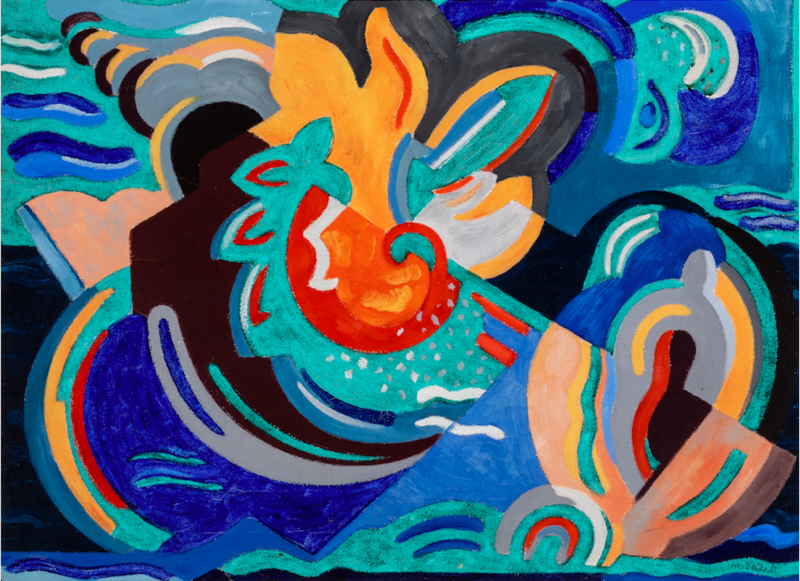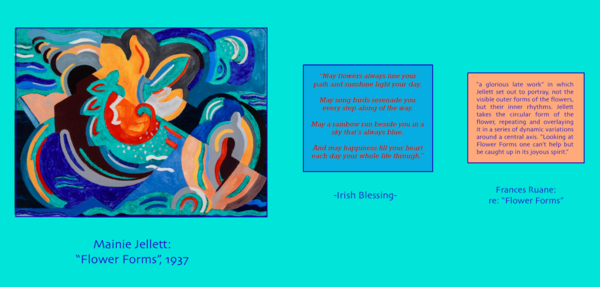Flower Forms

Mainie Jellett
Flower Forms, 1937
Mainie Jellett (Irish, 1897-1944), oil on canvas, The O'Brien Collection
The O'Brien Collection lent "Flower Forms" to the Snite Museum of Art in Fall 2018, to be a part of the exhibition "Looking at the Stars”: Irish Art at the University of Notre Dame.
Biography of Mainie Jellett, by Marty Fahey, Curator, O'Brien Collection
“Mainie” (Mary Harriet) Jellett was born and raised in Dublin (Fitzwilliam Square) and, like Lily Williams, received early art tutelage from May Manning and Elizabeth Yeats (sister of WB, Jack and Susan). Along with her contemporaries, Mary Swanzy and Evie Hone, Jellett is credited for introducing Modernism and Abstraction into Ireland in the early 1920s. She traveled to France with Hone for extended periods to learn from and to work on the theoretical underpinnings of Cubism with the artists Andre Lhote and Albert Gleizes. She also spent time in art studies with Walter Sickert and William Orpen—all great teachers! As such, her artistic career—much like Swanzy’s—can be identified by experiments/periods spent in various stylistic approaches to art.
Her longest-running pursuit was in the area of Cubism and Abstraction, as she saw its honesty of interpretation as an antidote to the Academic Realism which had dominated the artistic landscape for so long. She also saw that this approach most mirrored the great Irish art of the 7-9th centuries. She wrote and spoke widely on these topics.
Along with several other influential artists, she was one of the founders of the IELA, The Irish Exhibition of Living Artists, founded in 1943 for the purpose of giving a platform to and respect for Irish Modernists, whose work was either being ignored or rejected by more conservative art societies at the time. Sadly, she died before their first exhibit in 1944. In addition to painting and drawing, writing about and teaching art, Jellett also produced some wonderful designs for rugs.
“Flower Forms” is a late piece by her and pieces from this period tend—like this—to have both an exuberance of color and curvilinearity which differs from earlier work by her that tended, by comparison, to be more sedate/muted in coloration and angular in composition. Her artistic goal in the piece was to somehow capture the internal life-force, beauty and geometry within plant life rather than try to paint an accurate image of a particular type of plant as such.
________________________
We offer a reflection by Charlie Minter, Head of Sale, Irish Art, Sotheby's, London, on "Flower Forms":
“It is appropriate that Jellett’s Flower Forms is the chosen work for the month of May in the Irish Art . . . Amplified series, for when I look at this image, immediately I have the very pleasurable sense of warm, sunny days, shimmering seas and flowers coming to life—all evoked in Jellett’s dynamic and colourful handling. There is cobalt blue, aquamarine, peach, orange and red, which are strengthened by the blacks (shadows if one likes) that ground them. It looks like the work could have been produced in the south of France, although it likely relates to a commission of flower illustrations for the nursery at Howth Castle. Anyone who has experienced Ireland on one of those summer May days will know that, given its moment, it can rival any Mediterranean ‘côte’. The work is not, of course, a still life in the conventional sense; rather, it evokes the essence of 'flowerness.' Forms, as per the title, is what Jellett delights in. It is a wonderfully balanced, rhythmical composition, owing to Jellett’s critical and deep understanding of Cubism, learned directly in Paris under Andre Lhote and Albert Gleizes. The central flower, those orange petals, almost seem to be dancing in the wind.”
_______________________
And an Irish Blessing and further "reflection,"

Finally, we offer music and a video of a unique performance to enhance and amplify your experience of "Flower Forms."

Please visit THIS PAGE to experience "Flower Forms" while joining the nearly four million people around the globe who have listened to Jóhann Jóhannsson play his mesmerizing piano composition "Flight From The City" (from the studio album "Orphée"), all while watching a short, accompanying film directed and produced by Clare Langan.
Marty Fahey's observation: "Musically, Jóhannsson's “Flight from the City” is pared down to a mere repetition of four notes, distilled to their essence and yet beautifully dressed in harmonies which change ever so slightly: its simplicity is mantra or prayer-like. The video of the mother and daughter set to this music has an uncanny visual similarity to the rhythm, rotation in the painting too."